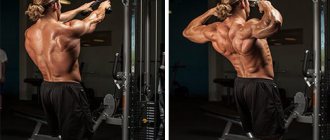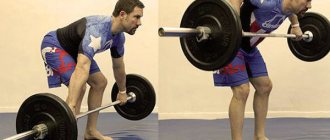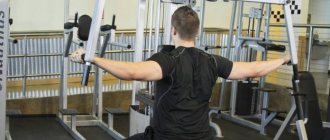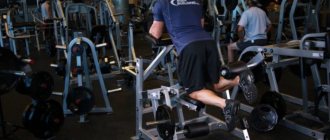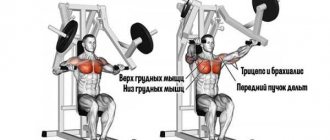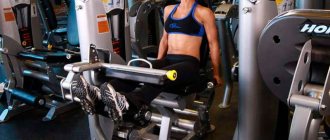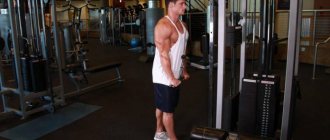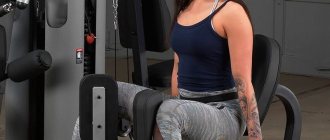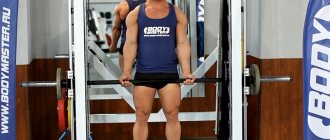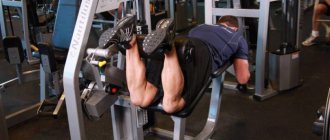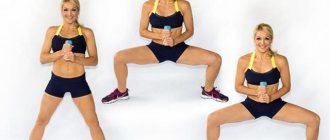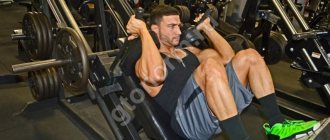Fitness and bodybuildingExercise
When training your rear deltoid muscles, do not waste precious time in line at the machine. Find out how to replace an exercise when you can’t get to the equipment you really need.
Author:
Bill Geiger
Training in an empty gym is a rare success. You can combine exercises into supersets as you please, use any equipment and fully enjoy the process! However, much more often the gym is filled with people, and it seems that they are all lined up for exactly the equipment or exercise equipment that you need here and now.
When the gym is full of people and all the machines are occupied by people who want to work out, it is very important to be able to find roundabout ways and know how to replace this or that exercise. If there is a long line at the apparatus for the key exercise of your complex, you can choose option B or even move on to options C and D.
Although it may seem like being forced to sit down near your favorite exercise machine confuses your cards, in fact, new opportunities are hidden in it. Knowing multiple variations of one exercise is the key to maximizing muscle growth. Various equipment and devices expose muscles to training stress with a unique direction of the total load vector, and this generates new stimuli for muscle growth.
Barbells, dumbbells, machines, cable rows and Smith machine - each type of equipment has its own characteristics and benefits, and none of them train muscles in the same way. Ultimately, when you include all types of equipment in your workouts, you work your muscles more fully and are less likely to hit a plateau in a given exercise.
Anatomy of the rear delts
The posterior bundle of the deltoid muscle originates from the lower edge of the spine of the scapula and is attached to the deltoid tuberosity of the humerus.
We recommend reading: Push-ups for the upper pectoral muscles
The posterior delta is involved in horizontal extension of the shoulder. Thus, the posterior bundle is a synergist for bench presses or push-ups, where the teres minor and infraspinatus muscles also take part. The posterior bundle is also involved in hyperextension of the shoulder, where the triceps serves as a synergist.
The back beam is the largest in volume, so it takes a lot of effort and time to work on it.
The rear delta is activated when the elbows are pulled back. It is for this reason that this muscle group is used during a number of back exercises. However, almost all basic exercises, such as deadlifts or front raises, do not affect this deltoids in any way. This is another reason why this muscle group is lagging behind in many athletes.
Anatomy of the deltoid muscle
The deltoid muscle is like a cover that fits over the shoulder joint from above, like a shoulder strap.
It is this muscle that gives the shoulder its roundness and smooth shape.
The delta is heterogeneous - bundles of protein fibers intertwine at different angles, which contributes to the division of the muscle into lobes, bundles or sections. Each part of the deltoid muscle performs its own task.
Main function of each part:
- Anterior delta – flexion of the shoulder and its movement “inward”, as a result, the arm is raised.
- Medium – arm abduction.
- Posterior – extension of the arm and simultaneous rotation of the arm to the outside, resulting in lowering of the raised limb.
Recommendations for pumping deltas
There is no universal exercise for the deltoid muscles. Basic exercises involve several bundles, but individual zones are still a priority. Therefore, the training program should include a variety of movements for all three beams.
It is extremely rare that this muscle group develops evenly. As a rule, some bundles lag behind - most often these are the back and middle ones, since they are either forgotten about, or the exercises are performed incorrectly, or they do not do enough work, concentrating on the presses alone. Over time, you can focus on these particular beams, starting your shoulder day not with a bench press, but with swings on the rear and middle deltoids. But at the initial stage it is necessary to lean on the base, while not forgetting to pay attention to each beam. For beginners, two or three movements will be enough. Experienced athletes use 2-4 basic and 2-4 isolation exercises.
The recommended number of approaches per movement is 3-5, the number of repetitions is 8-15. It is recommended to train your shoulders once a week. Only with specialization among experienced athletes can deltas be divided into bundles over two to three days.
Pay special attention to warming up. Shoulders are a complex complex that can be easily damaged. It makes sense to include shoulder movements in the program after training the large muscle groups of the body. This will prepare the deltoids for stress and reduce the risk of injury.
We recommend reading: How to properly pump your legs
If you experience pain in your joints and ligaments, stop training immediately. It is best in such cases to contact a specialist. By ignoring the problem, you risk missing out on pumping your case for several months.
Working muscles and grip methods
Reverse flyes directly affect the deltoid muscles (namely, the posterior fascicles). Additionally included:
- trapezius muscle;
- diamond-shaped
Reverse flyes in the simulator can be performed using different grip options:
- the classic, most common type of grip is when the palms are on the vertical handles of the exercise machine opposite each other, and the thumbs are pointed at the ceiling;
- another type of grip is the opposite of the classic one - the hands are directed towards each other with the backs of them, the thumbs are facing the floor, the grip is carried out by the vertical handles;
- the last grip option is specific, since most of the simulators do not have handles for this type of grip - the grip is carried out by the handles, which are located horizontally, the thumbs are directed towards each other, and the palms are facing down.
Exercises for the rear deltas in the simulator
Pull of the upper block to the face
This exercise is isolated and is aimed at working out the rear deltoids. It's great for beginners and will help build the neuromuscular connection between the brain and shoulders. It will also allow you to practice your technique for performing more complex, basic exercises. The block to face row is not a bulking exercise, but it will help give your deltoids an expressive shape. Thus, it gives the shoulders a spherical appearance. It is performed in a crossover.
Execution technique
Initial position:
- Install the crossover block at face level (maybe a little higher).
- Next, select a handle. The most common is the cable handle. This is where I advise you to start, and then decide for yourself which one to use in the future.
- Step back two steps to tighten the crossover cable.
- Keep your back straight, you can lean back a little.
- Feet are shoulder-width apart and slightly bent at the knee.
Performance:
- Inhale and as you exhale, pull the handle towards your face, moving your elbows back as far as possible. While pulling, stretch the cable handle in different directions.
- Hold this position for a few seconds and return to the starting position with your arms straight.
As you can see, there is nothing complicated in this exercise, the main thing is to try to work exclusively with the back beam. You can pull the rope either towards your face or towards the middle of your pectoral muscles. Experiment with which option suits you best, then do it.
Raising arms in a crossover from the upper block
A very powerful exercise for creating a beautiful rear deltoid shape. Also, unlike the block pull to the face in the fly, each hand works separately. And we know that thanks to this, we can better work out the left and right deltas separately. Thus eliminating the imbalance in strength and appearance. Although the exercise looks easy, it is very difficult technically. The whole difficulty lies in the fact that it is very easy to deviate a little from the technique. To transform the exercise, we train not the shoulders, but, for example, the trapezius or triceps. To prevent this from happening, it is important to avoid certain things:
- Raise and bring your arms together at the same height. There is no need to lower your arms down while raising your arms, thereby engaging the latissimus muscles in the work.
- Do not straighten your arms while moving. The main task when performing crossover flyes is to keep your arms motionless and slightly bent at the elbow joint. If you straighten them, the triceps will join in the work and take on the entire load.
- Don't squeeze your shoulder blades. We have already discussed this point earlier. When bringing the shoulder blades together, the trapezoid is connected.
Make sure that only the rear deltas are worked.
Execution technique
Initial position:
We recommend reading: Protein for cutting
- Place the crossover blocks at a level just above your shoulders.
- Take the left cable in your right hand, and the right cable in your left and cross them. Bring your hands together at eye level.
- Step back a few steps to tighten the cables.
- Keep your back straight, with a slight arch in your lower back. There is no need to lean to either side.
- Move your shoulders forward slightly to stretch your trapezius.
- Feet shoulder width apart. You can bend them a little at the knee.
Performance:
- Take a deep breath and as you exhale, spread your arms to the sides, moving your elbow back. Stay in this position for a few seconds.
- And while inhaling, bring your arms back to the starting position.
Don't make jerky movements. Raise and lower your arms smoothly and under control. Feeling how the rear bundle of deltas contracts and stretches.
Raising arms in the simulator
This is the final exercise. It is performed while sitting in the Peck-Deck simulator. This is a kind of swing. Only if we work in them standing with dumbbells, then we will sit in the simulator. What will this give us? The load will be removed from the lower back, which is a huge relief for many, especially for people who have injuries in this area. And also, we can not worry about balance and focus all our attention on the work of the rear delts. The exercise is isolated. It is better to do it after the main exercises.
Execution technique
Initial position:
- Before you begin the exercise, you need to adjust the machine.
- Place the handles of the machine back so that they are behind the back of the machine at shoulder width.
- Sit on the seat facing the back and rest your chest against it.
- Grab the handles. You can use any grip: regular, reverse or parallel. There will be no difference in the effect on the muscles; rather, it’s just a matter of convenience.
- Move your shoulders forward slightly to stretch your trapezius.
Performance:
- Take a deep breath and as you exhale, move your arms back, thereby contracting the rear bundle of deltas.
- Stay in this position for a while, and as you exhale, begin to bring your hands towards each other, returning your hands to their original position.
Since we have moved our shoulders forward, our range of motion decreases. Because of this, it will be necessary to increase the number of times in the approach. This is done in order to increase the time the muscle is under load.
Calculate your ideal sports weight!
Technique: standing bent over fly
The exercise can be done either standing or lying face down on a bench. They often make a mistake - they advise bending 45 degrees to the axis of the spine or to the floor. This results in the inclusion of stabilizers and diamonds rather than deltoids. The tilt should be complete - the spine is in a plane parallel to the floor.
The movement itself looks like this:
- Take light dumbbells, since you only need to pull them with one small muscle;
- Full tilt is performed as above;
- The athlete slightly bends his elbows and brings his elbows up, just above the plane of the floor;
- The shoulders do not pull towards the ears and do not move from their neutral position;
- At the top, fixation occurs for 3-5 seconds to feel the muscle;
- Dumbbells smoothly lower down
This movement requires a good knowledge of muscle anatomy and “body feel.” Look in the atlas where the rear deltoid is located, and if it does not work during the swing, you should pay attention to analyzing the errors.
It's a DUMBLEL SWING, baby!
Exercises for the rear deltas from Yuri Spasokukotsky
Exercise: Smith machine rear delt row. A bench is necessary in order to remove the load from the spine. You can also use a power belt to avoid injury. When performing deadlifts, you do not need to retract your shoulder blades because the rear deltoids lose load. For starters, 3 sets of 15 repetitions will be enough, and for experienced ones - 15 warm-up times and 3 sets of 6-8 repetitions. You should take a short break between approaches, otherwise you can seriously tear your muscles.
Tip: It is not recommended to work out one muscle group more than once a week. But you should train efficiently and intensively.
A slightly rounded back when performing deadlifts, as well as a head lowered all the way down, gives the posterior muscle bundles a colossal load. The lower the inclination of the bench, the higher the load on the deltoids.
Common mistakes
- Incomplete amplitude when performing exercises.
- Long pauses between repetitions when lifting dumbbells.
- During exercise, your back should be straight.
- Insufficient angle of inclination, the load is shifted to the back.
- Insufficient warm-up, which leads to injuries, since the muscles are not “warmed up”.
- Sudden movements or, conversely, blurred movements when performing exercises.
- At the end of the amplitude, beginners straighten their arms, which relieves tension from the shoulders and transfers it to the back, keeping the arms half-bent and fixed.
Recommendations: how to pump up your rear deltoids
- In order for your shoulders to noticeably increase in volume, you need to work with more weight.
- It is important that the number of repetitions does not exceed 12 times, optimally 8-12.
- Both men and women need to feel a good load; it is the burning sensation in the muscle during the last repetitions that indicates the correct choice of weight.
- The last two repetitions must be performed with all your might - this is a very important condition.
Only if all recommendations are followed, muscle growth is ensured.
Girls do not necessarily need to develop their posterior delta with exercises in the weight training mode. The endurance mode is quite suitable - 15-20 repetitions of 3 sets, while the muscles will have a sporty and feminine appearance.
Also, do not overload , do no more than 1-2 workouts per week. Tired and overtrained muscles will not increase in volume and training will simply lose its meaning. Equally important for muscle growth is nutrition , especially after training. The formation of new muscle fibers requires proteins, fats and carbohydrates. It is proteins and carbohydrates that are the building materials and energy fuel for muscles. Eat 4-5 times a day, and after training, eat food within 40 minutes, and then you will get beautiful and shaped shoulders.
Basics of the workout
Each part of this muscle needs to be trained separately. In addition to large muscles, there are also smaller muscles in the shoulders: infraspinatus, supraspinatus, teres minor, teres major, subscapularis.
Pumping deltas has its own characteristics:
- Correct execution of the technique is mandatory. Hands should be kept parallel to the floor.
- The weight must be significant - so that it is difficult to lift it even 10-14 times. The load must be noticeable in order for the muscles to be worked out efficiently.
- When performing dumbbell lifts, it is best to sit on a bench or stable stool. The body should be tilted at about 40-50° relative to the vertical.
Most often, the middle and rear deltoids, subscapularis, and back muscles are involved.
Tips for Maximum Productivity
- Work with the correct technique, performing movements using the rear deltas.
- Do not make sudden jerking movements. Take care of your shoulders!
- Eliminate the trapezoid from the movement. In order to do this, you need to move your shoulders forward, thereby stretching it across your back.
- If the rear deltas are lagging behind in development, then start shoulder training with them.
- Use dumbbell crossover exercises to correct imbalances between the right and left sides.
- Start training your deltoids with heavy basic exercises. Leave the isolated ones for last.
Front lift
This method is included in the basic exercises for pumping up the shoulders. It helps to achieve excellent relief in the shortest possible time. This exercise also works the chest muscles well.
Training stages:
- While sitting on a bench, you need to grab the dumbbells with a neutral grip. The arms are located along the body.
- You need to slowly raise your straightened arm to shoulder level so that the projectile is parallel to the floor.
- Return to the starting position and perform the approach with the other hand.
Required number of repetitions: 2-3 sets of 12-15 movements per arm.
Lateral lift
It is very important to perform the exercise correctly, otherwise its effectiveness will decrease to zero.
Brief instructions:
- Starting position: standing straight, back straight, shoulder blades connected, limbs along the sides. Dumbbells can be grabbed with any grip.
- Slowly raise your palms to shoulder level and hold for a second.
- Smoothly, without jerking, return to the starting position.
You cannot lift the dumbbell above the collarbone so that the load is not redirected from the shoulder to the trapezius of the chest.
The exercise should be performed many times: 30-50 times per session.
